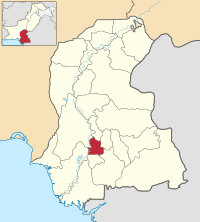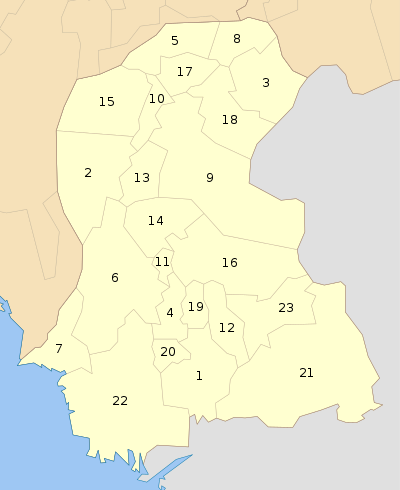Hyderabad District, Sindh
Haiderābād District (Sindhi: ضلعو حيدرآباد Urdu: ضِلع حیدرآباد),![]()
Hyderabad حيدرآباد | |
|---|---|
 Map of Sindh with Hyderabad District highlighted | |
| Country | Pakistan |
| Province | Sindh |
| Headquarters | Hyderabad |
| Government | |
| • Last Deputy Commissioner | Rizwan Ahmed |
| Population (2017)[1] | |
| • Total | 2,199,463 |
| Time zone | UTC+5 (PKT) |
| Number of Tehsils | 4 |
| Website | www.hyderabad.gov.pk |
Geography
Hyderabad District is 104,877 hectares in size.[3] 14,250 hectares of the district are under wheat cultivation, with a total annual production of over 55,000 tonnes.[3]
Administration and government
The city of Hyderabad is where the district headquarters were located and the district government used to be seated. The last Deputy Commissioner of the district was Rizwan Ahmed.[4] The old Hyderabad district included the adjoining districts of present-day Hyderabad: Matiari, Tando Allahyar and Tando Muhammad Khan. Even before that until the early 1970s the district included all the four districts mentioned above as well as the Badin district. This administrative setup was demolished by former President Pervez Musharraf in 2001 when he introduced the local body government.
Demographics
The predominantly Muslim population supported Muslim League and Pakistan Movement. After the independence of Pakistan in 1947, the minority Hindus and Sikhs migrated to India while the Muslim refugees from India settled in the Hyderabad District.
The population of the district was enumerated at 2,199,000 at the 2017 Census.
Combined population of these four districts (not including Badin) as per the 1998 census was 2.891M out of which 1.469M people lived in urban while the rest 1.422M people lived in the rural areas. According to the 1998 census results for the four talukas of Hyderabad, Hyderabad City, Latifabad and Qasimabad, the major first languages were as follows: Urdu (32%), Sindhi (53%), Punjabi (5.5%), Pashto (2.9%) and Saraiki (1.6%).[5]
First Languages of Hyderabad district
Rapid Immigration to urban areas from other areas of Sindh and Other provinces led to growth in Hyderabad recorded in 2012 June at more than 6.5%.
References
- "DISTRICT WISE CENSUS RESULTS CENSUS 2017" (PDF). www.pbscensus.gov.pk. Archived from the original (PDF) on 2017-08-29. Retrieved 2017-09-03.
- Azfar, Sara. "SINDH SECONDARY CITIES URBAN SECTOR ASSESSMENT" (PDF). URBAN MUNICIPAL SERVICES. ASIAN DEVELOPMENT BANK. Archived from the original (PDF) on 26 February 2017. Retrieved 15 December 2017.
- Siyal, Altaf Ali (January 2015). "Remote Sensing and GIS based wheat crop acreage and yield estimation of district Hyderabad, Pakistan". Mehran University Research Journal of Engineering and Technology. Retrieved 14 December 2017.
- "BBC News - SOUTH ASIA - Pakistan's district commissioners bow out". news.bbc.co.uk. Retrieved 11 April 2018.
- PCO 1999, pp. 117–19.
Bibliography
- 1998 District census report of Hyderabad. Census publication. 59. Islamabad: Population Census Organization, Statistics Division, Government of Pakistan. 1999.
